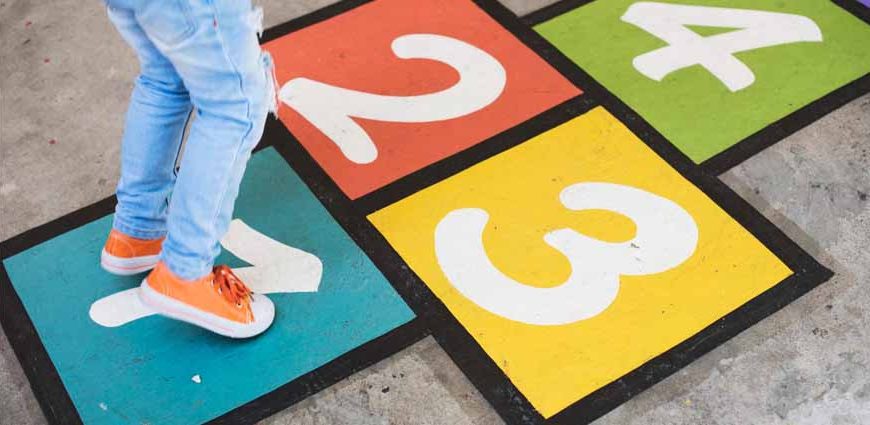“Hopscotch is a simple game that can be played by anyone in most outdoor places. It encourages physical activity, creativity, and social skills. The game is played by people around the world. Games like this are crucial in the modern world because they limit screen time and encourage engagement with the natural world.”
– Alyssa Anderson, writer at WebMD
Children love to play, and research has proven that they practise and assimilate much of what they learn when they play. When children play, they develop their various skills – cognitive skills, language skills, motor skills, social skills, and so much more.
The Hopscotch game for preschoolers is one such game that has been around for ages. Most of us remember playing some version of this game when we were younger. It is enjoyable, doesn’t need much equipment or materials, versions of this game can be played indoors and outdoors, and has many educational and health benefits for the child.
Origin of the Hopscotch Game for Preschoolers
Playing Hopscotch can be traced back to ancient Rome and Britain during the early Roman Empire. A version of this game was invented to train Roman soldiers as part of their military training exercises with armor and improve their footwork. The Roman children drew similar but smaller hopscotch courts to imitate the soldiers and made their scoring systems.
The hopscotch game is popular all over India and the world. It is known by names like Marelle/ Escargot in France, Himmel und Holle in German, Laylay or Khane bazi in Persian, Potsy in New York City, etc. In contrast, in India, it is called Kith-Kith, Stapu, Langdi in Hindi speaking areas, Langdipai in Maharashtra, Ekka Dukka in Bengal, Kunte Bille in Karnataka, Paandi in Tamil Nadu, and so on.
Elements, Rules, and Goal of the Hopscotch Game
Whatever the name or the variation, the two basic elements of the game remain the same- the Hopscotch court and the marker, like a stone, a piece of tile, a small bean bag, or another small object.
The basic rule of hopscotch for preschoolers is that each player has to throw a marker into one of the numbered squares without touching the lines (in serial order), then hops through the court to retrieve the marker, again without touching any of the lines.
The goal of each player is to hop to the end of the court and back without the other foot touching the ground.
How to Play the Hopscotch Game for Preschoolers? 10 Fun and Easy Steps to Follow
For you: Enrol your child in India’s leading preschool network.
Did you know that hopscotch gross motor skills can be encouraged as children jump, hop, skip, fall down, get up and learn to balance?
- We must first draw a court that consists of squares from numbers 1 to 10 (8 for an easier version for preschoolers). You can refer to the diagram below.
- Use chalk if you’re playing outside or coloured tape/ washable paints if you’re playing inside.
- Take a marker – a small stone, twig, a small bean bag and throw it on the first square or the square marked 1- if it doesn’t land on the right square or it lands on the line, then you lose a turn, and the next player gets a try.
- If your marker lands correctly on the square, then you have to hop on one foot to the next empty square and hop over the square your marker is on. E.g., if your marker is on square 2- then you hop on square 1, hop over square 2, and land on square 3 directly.
- If the squares are in pairs, you land on both squares with one leg on each square (refer below).
- When you reach the end, turn around (use 1 foot if it is a single square or use two feet if there are two squares side by side.) and head back towards the starting point.
- On the return journey, the player hops till they reach the square where the marker is, and then, without stepping into that square, the player retrieves their marker and continues their journey to the start point.
- Upon completing this round, the player will continue to the next number, or the next player will get their chance.
- When your turn returns, you throw the marker to the next square.
- The player who finishes all the numbers first wins.
5 Ways to Hike up the Fun of the Game
Hopscotch activity for preschoolers helps improve their motor skills, balance and overall coordination of their physical movements. Nevertheless, here are five additional hopscotch rules to increase the fun for preschool kids.
- The first player continues their turn till they miss a square, falls, jumps outside the line, or touches the line, and then it is the next player’s turn.
- For smaller children, fewer numbers can be used. Even the size of the squares can be adjusted according to the age of the players.
- Instead of numbers, you can play with coloured squares. Or have squares with different images drawn on them, like a bird, fruit, etc. You can even let the children draw the images.
- Allot a specific category to each square, and as the player lands on the square, they must shout out an item in the category. Fruits, vegetables, country, beverage, and food are some categories that can be used. Care should be taken so that the player doesn’t repeat another player’s item.
- Use a timer for each player; the player who finishes the most squares in the given time frame wins. Make sure to integrate these hopscotch rules while playing with preschool kids. These are some of the ways to increase hopscotch gross motor skills in kids.
Whatever variation you choose, either the ones given above, the original version, or one made up by you, the game of Hopscotch will provide hours of fun provided you remember the basic elements of the game, which is the hopscotch court and the marker.
The benefits of playing Hopscotch are noteworthy, so let us now look at how the Hopscotch game aids in child development skills.
6 Amazing Benefits of Playing a Hopscotch Game
Here are the Benefits of Playing a Hopscotch Game
- Cognitive Development
- Gross Motor Development
- Eye-Hand Coordination
- Bilateral Coordination
- Mathematical Skills
- Social Skills
The game has a set of rules which a child must know and memorise, which is not an easy task when playing Hopscotch with preschoolers-
o They must remember when it’s their turn.
o Where their marker last fell.
o They need to know when to land with one foot and with two.
o Which block do they have to hop over and
o Remember to pick up their marker on the way back.
o Along with these rules, they also need the brain to help them balance their actual physical movement.
When playing Hopscotch-
o Children develop their core strength as they move and control their bodies while navigating the court.
o They learn to balance their bodies as they jump and hop from one square to another and switch from 1 foot to using 2 feet and then back to 1 foot again.
This is one of the more difficult skills for a preschooler, yet it is one of the important skills required for many sports and other games. In the hopscotch game, the child needs to learn how to throw the marker so that it falls perfectly inside a square without touching any lines. This is a good game for them to practise this skill.
This is the child’s ability to coordinate both sides of their body in proper balance as they go about their daily tasks like dressing up, eating, and putting on their shoes, as well as for sporty activities requiring movements like running, hopping, climbing, riding a bike and so on. When playing Hopscotch, preschoolers learn how to balance and coordinate their body movements as they hop and jump on their feet during the game.
The Hopscotch game is all about numbers-
o The court is numbered.
o They learn to recognize the name and shape of each number.
o Some of the numbers need to be recognized even upside down.
o The child must know which number to throw their marker at.
o They have to count upwards as they hop through the court.
Playing hopscotch games with preschool children will help with their early mathematical skills and may even help them develop a love for Mathematics.
Along with learning how to play Hopscotch, the children are also learning important life skills and social skills like-
o Waiting their turn.
o Cooperating with other players.
o Being considerate
o Cheering for the other players.
o These games also teach children how to handle themselves when they lose and be a good sport.
The game of Hopscotch will encourage our young children to go outside and play. Playing outside has its own added benefits like exercise, breathing in the fresh air, spending all the pent-up energy, helps develop a good appetite, to name a few, and hence it is okay to indulge in such activities.
Conclusion
Hopscotch has been an excellent game in improving gross motor skills of children. In this article, we have provided detailed information on the origin of hopscotch games for preschoolers. We have also discussed the game’s elements, rules, and goals. We have suggested 10 fun and easy steps to follow in the game and given ways to increase the game’s fun.
At Preschool like EuroKids, we do our best to ensure that the children participate in a wide array of activities, each designed to target specific and even a combined set of developmental skills necessary for them to go about their daily activities smoothly and transition from one to the next.
Are you ready to create memorable experiences with your children by playing hopscotch?
For informative and accurate articles on all things related to your new born-toddler’s development, growth, health and nutrition, follow EuroKids Blogs and do check out our nationally recognized preschools – EuroKids for the first step in your kid’s educational journey!
















